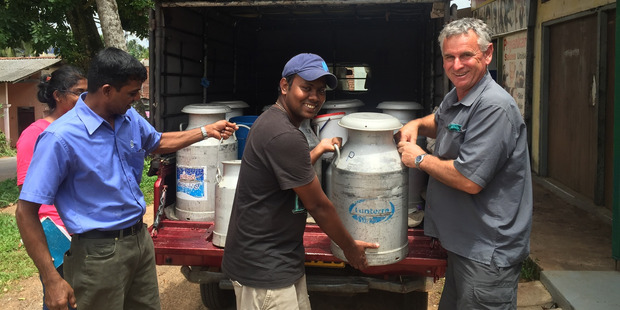July, 7, 2016

Murray Douglas is back from a month spent voluntarily helping Sri Lankan farmers produce more and better milk from small herds, many consisting of 1-10 cows.
The Titoki farmer - who with his wife and sons is establishing dairy farms in Brazil - was among four volunteers recruited by Fonterra to carry out work which helps safeguard the co-operative's trade with the Indian Ocean island nation of more than 20 million people.
The Fonterra-owned business in Sri Lanka has a turnover of over $500 million and will this year import more than 63,000 tonnes of New Zealand milk powder.
Mr Douglas said Sri Lanka had stopped importing New Zealand milk powder during a food contamination scare in 2014 and Fonterra had closed its dairy factory near Colombo for several days because of fears about staff safety.
While the contamination proved unfounded, a subsequent survey found Fonterra was perceived as a multinational with little concern for the people of Sri Lanka.
To change this perception, Fonterra decided to build a training farm to help improve production on the 2000 small dairy farms which supply the company with 30,000 litres of milk daily.
The co-operative called for NZ dairy farmer volunteers to provide expert advice and from 106 applicants selected Mr Douglas along with Troy Doherty from Bay of Plenty, Tim Phillips from Waikato and Marloes Levelink from Otago.
Building of the 30-cow training farm started last August and Prime Minister John Key opened the facility in April.
Mr Douglas said there were only about six large-scale dairy farms in Sri Lanka. He was helping farmers who received 65-70c for milk they got from as few as one or two tethered cows.
About 60 per cent of his time was spent working with 23 supplier relations officers whom he described as a cross between milk supply sourcing people and farm advisers.
Employed by Fonterra, the supplier relations officers were well educated in dairying theory but lacked practical experience.
Mr Douglas said this made it a challenge to get across to them small changes in techniques Sri Lankan farmers could use to boost production.
"If a supplier had a cow he was feeding stalky grass he cut from roadsides it could produce perhaps 20 per cent more milk if the farmer selected better feed when he was gathering it," he said.
"It was also difficult to explain that if a farmer wanted to double his herd from five to 10 cows he would need to double feed production."
Big forage gardens were being established at the training farm, with 10,000 napier or elephant grass plants spaced in rows across each hectare. The grass was cut at a metre in height and the feed taken to housed cows.
Tropical weeds were aggressive and, with glyphosate banned in Sri Lanka, 20 people with hoes had been needed to keep the gardens free of unwanted plants.
Cows there had traces of Jersey and Fresian genetics, but were otherwise typically tropical cattle with drooping ears and large dewlaps.
Milk was taken to collection centres, one of which had 80 suppliers bringing in a total of 1200 litres daily.
Mr Douglas said many Sri Lankans were Buddhists with a different emotional and cultural attitude toward animals than New Zealanders.
Most farmers there had poor educations and few resources, but they liked Fonterra because it had introduced reliable payment for milk their cows produced. Also, through showing interest in their herds Fonterra was building a high level of trust.
While there was no guarantee the training farm would protect the co-operative's market in Sri Lanka, Mr Douglas said it was progressing well and the involvement with local farmers was a point of difference between others buying milk.
- The Country
Photo - Murray Douglas (right) with a collection truck driver who has picked up the milk from about 20 Sri Lankan suppliers. Photo / Fonterra
Video Story